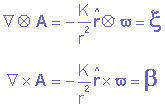|
6.1 The A field How does an elementary particle read a field, thus reacting to its implicit content? Let us think of a force field that be electric, magnetic or gravitational. These are effect fields, i.e., areas of space endowed with some particularities and producing measurable effects on certain test objects. Therefore it exists a local and specific potential which is provoked by a physical property continually varying from point to point. Any particle of finite dimensions —so long as it is sensitive to this local property— reacts to this field; in a similar way to a macroscopic object when submitted to a windstorm. An electric field x can be thought of as a specific derivative of another vectorial field A, since A mathematically comprehends this function. So let us suppose that this A field does exist and possesses —on every point of its domain— all the directional derivatives and is consequently endowed with regular field lines. For example, in order to satisfy hypothesis 4 (H-4), we had to imagine what the A field of an electron should be:
in which
and this equation —according to the Cartesian reference model (v // k)— changes into
Consequently, Ax = C1 and Ay = C2 —with C1 and C2 constant. If we recall that A represents the local content of electromagnetic information in transit —emitted by the electron (H-2 and H-3)— we must have
and, therefore, C1 = C2 = 0. Under these conditions l coincides with the z axis and the expression for Az has as a solution Az = K/r + C3 which for similar reasons to what was discussed above (for C1 and C2) has C3 = 0. The solution for 6.2 will be —with w defined in H-1:
agreeing with H-3 and —as we shall see below— with H-4; therefore, it is the electron at rest equation. Now calculating the translational and the rotational of A with its value defined by 6.3 we easily get to the expressions:
in which b (in 6.4) satisfies Biot-Savart’s law; therefore, it is the magnetic effect field of an electron at rest —and A totally satisfies the basic hypotheses. It is interesting to notice that we began our arguments using Coulomb’s law for a sphere with an infinite radius, and we arrived at Biot-Savart’s law; it is more interesting to verify the mathematical reversibility of theoretical path: it is possible to leave from Biot-Savart’s law and arrive at Coulomb’s law. In fact, these laws are mathematically equivalent and equations 6.3 and 6.4 operate the transformation from one into another. 6.2 The fundamental equations of the electromagnetostatics The field of electromagnetic effects of an electron at rest is summarized by the following system of equations
with A given by 6.3. Since fields x and b are addictive (Superposition Principle) but the translational, unlike the rotational, does not obey the distributive property, system 6.5 is not to be generalized to all electromagnetic fields. In other words, the electromagnetic field (x,b) of a population of electrons cannot as a rule be expressed in terms of a single A vector [This fact answers for the unyielding character of Maxwell’s equations]. In this case then have
The corresponding effect equation is
with x and b calculated by 6.6; Fj is the electromagnetic force that acts upon an electron j placed in an electromagnetic stationary field; K1 and K2 are constant. Equations 6.5 and 6.6 keep in their contents the totality of the electromagnetostatics (with the exception of an important factor related to the induction field t mentioned in item 3.3). 6.3 The scalar electromagnetic field It is possible [39] to consider the electromagnetic field of an electron through a scalar function φ given for
Therefore, it is enough to define x and b through the expressions
and to observe that the function φ presents the following properties
So, we can easily demonstrate that
and consequently the compatibility between 6.8 and 6.3. 6.4 The electromagnetic information (e.m.i.) Equations 6.9 show us that the electromagnetic field (x,b) of the electron can be described in terms of the gradient of a function position φ. So, we may conjecture about the actual existence of something emitted by the electron and call it electromagnetic information (e.m.i.). Equation 6.8 suggests something else —once emitted the e.m.i. are preserved. In other words the electron is an e.m.i. emitter source and the e.m.i. flow that crosses any surface identifies itself with the flow of an h vectorial field expressed by
It is implicit in these considerations that h belongs to the h = ρc type, when ρ is an invariant that represents the local density of e.m.i. and c is the speed spread by these e.m.i. in an appropriate reference system.
|


